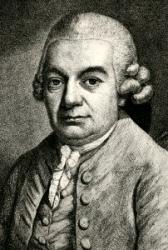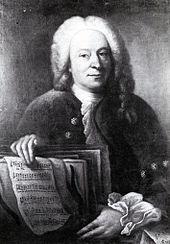Planning worship?
Check out our sister site, ZeteoSearch.org,
for 20+ additional resources related to your search.
- |
User Links
Browse People
Manuel Baca Garcia
Person Name: M. B. Garcia Translator of "Quién Quisiera Oír" in Melodias Evangélicas
Manuel Baca Garcia
Carl Philipp Emanuel Bach

1714 - 1788 Person Name: C. P. E. Bach Composer of "MILLER" in Himnario de la Iglesia Metodista Episcopal Carl Philipp Emmanuel Bach, born at Weimar, March 14, 1714; music director at Hamburg, a prolific composer, great in all departments; as a writer of sings, odes, pslams, etc., he surpassed all his contemporaries; died at Hamburg, of consumption, Sept. 14, 1788.
A Dictionary of Musical Information by John W. Moore, Boston: Oliver, Ditson & Company, 1876
Carl Philipp Emanuel Bach
Emmon W. Bach
b. 1929 Person Name: Emmon Bach, 1929- Author of "O Light of Life" in Singing the Living Tradition
Emmon W. Bach
Friedmann Bach
Composer of "[Each blade of grass so humble]" in The Children's Hymnal
Friedmann Bach
G. D. M. Bach
Person Name: D. G. M. Back Translator of "Christmas Is Here With Joy Untold" in American Lutheran Hymnal
G. D. M. Bach
Johann Christoph Bach

1642 - 1703 Person Name: J. Chr. Bach Composer of "[Brethren, called by one vocation]" in The Lutheran Hymnary
Johann Christoph Bach
Johann Sebastian Bach

1685 - 1750 Harmonizer of "SALZBURG (HINTZE)" in Voices United Johann Sebastian Bach was born at Eisenach into a musical family and in a town steeped in Reformation history, he received early musical training from his father and older brother, and elementary education in the classical school Luther had earlier attended.
Throughout his life he made extraordinary efforts to learn from other musicians. At 15 he walked to Lüneburg to work as a chorister and study at the convent school of St. Michael. From there he walked 30 miles to Hamburg to hear Johann Reinken, and 60 miles to Celle to become familiar with French composition and performance traditions. Once he obtained a month's leave from his job to hear Buxtehude, but stayed nearly four months. He arranged compositions from Vivaldi and other Italian masters. His own compositions spanned almost every musical form then known (Opera was the notable exception).
In his own time, Bach was highly regarded as organist and teacher, his compositions being circulated as models of contrapuntal technique. Four of his children achieved careers as composers; Haydn, Mozart, Beethoven, Mendelssohn, Schumann, Brahms, and Chopin are only a few of the best known of the musicians that confessed a major debt to Bach's work in their own musical development. Mendelssohn began re-introducing Bach's music into the concert repertoire, where it has come to attract admiration and even veneration for its own sake.
After 20 years of successful work in several posts, Bach became cantor of the Thomas-schule in Leipzig, and remained there for the remaining 27 years of his life, concentrating on church music for the Lutheran service: over 200 cantatas, four passion settings, a Mass, and hundreds of chorale settings, harmonizations, preludes, and arrangements. He edited the tunes for Schemelli's Musicalisches Gesangbuch, contributing 16 original tunes. His choral harmonizations remain a staple for studies of composition and harmony. Additional melodies from his works have been adapted as hymn tunes.
--John Julian, Dictionary of Hymnology (1907)
Johann Sebastian Bach
Sarah Bache
1771 - 1844 Person Name: Bache Author of ""See how he loved!" exclaimed the Jews" in The New Congregational Hymn and Tune Book, for Public, Social and Private Worship Bache, Sarah, 1771-1844, kept a school for many years in Birmingham. Her hymn, "'See how he loved,' exclaimed the Jews," Love of Christ, was contributed to the Exeter Collection, 1812. It is in Martineau’s Hymns for the Christian Church and Home and Belfast Collection, and most of the early books after its appearance.
--John Julian, Dictionary of Hymnology (1907)
Sarah Bache


 My Starred Hymns
My Starred Hymns


